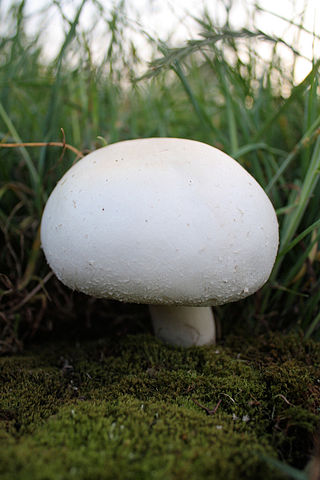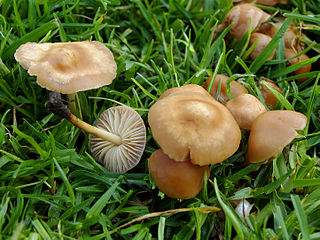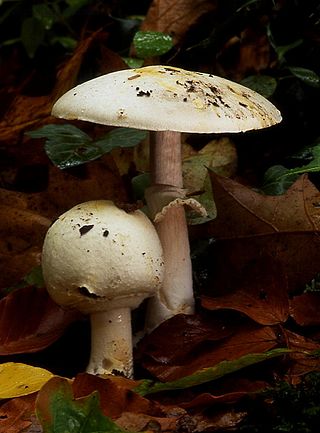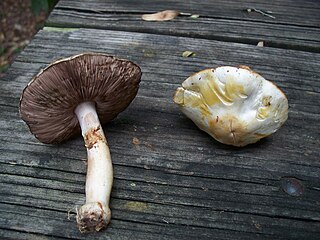
Macrolepiota procera, the parasol mushroom, is a basidiomycete fungus with a large, prominent fruiting body resembling a parasol. It is a fairly common species on well-drained soils. It is found solitary or in groups and fairy rings in pastures and occasionally in woodland. Globally, it is widespread in temperate regions.

Agaricus arvensis, commonly known as the horse mushroom, is a mushroom-forming fungus of the genus Agaricus.

Agaricus campestris is a widely eaten gilled mushroom closely related to the cultivated A. bisporus. A. campestris is commonly known as the field mushroom or, in North America, meadow mushroom.

Clitocybe nebularis or Lepista nebularis, commonly known as the clouded agaric, cloudy clitocybe, or cloud funnel, is an abundant gilled fungus which appears both in conifer-dominated forests and broad-leaved woodland in Europe and North America. Appearing in Britain from mid to late autumn, it is edible, but may cause gastrointestinal issues.

Panaeolus semiovatus var. semiovatus, also known as Panaeolus semiovatus and Anellaria separata, and commonly known as the shiny mottlegill, ringed panaeolus, or egghead mottlegill, is a medium-sized buff-colored mushroom that grows on horse dung, and has black spores. Though nonpoisonous, it is generally regarded as inedible, and a few people experience gastric upset after consumption.

Marasmius oreades, also known as the fairy ring mushroom, fairy ring champignon or Scotch bonnet, is a mushroom native to North America and Europe. Its common names can cause some confusion, as many other mushrooms grow in fairy rings, such as the edible Agaricus campestris and the poisonous Chlorophyllum molybdites.

Agaricus silvicola, also known as the wood mushroom or woodland agaricus, is a species of Agaricus mushroom related to the button mushroom. A. silvicola is a member of Agaricus section Arvenses, a group of morphologically similar mushrooms. A. silvicola, like other species in Agaricus section Arvenses, exhibits a positive Schäffer's reaction and potassium hydroxide reaction, and smells of almonds or anise.

Leucoagaricus leucothites, commonly known as the smooth parasol, woman on motorcycle, ma'am on motorcycle, white dapperling, or white agaricus mushroom, is a species of agaric fungus. The species was originally described as Agaricus leucothites by Carlo Vittadini in 1835, and bears similarity to species of that genus. Solomon Wasser transferred it to Leucoagaricus in 1977. While sometimes regarded as edible, the species is suspected of being poisonous due to gastric-upset-causing toxins. It could also be confused with the deadly Amanita ocreata.

Agaricus abruptibulbus is a species of mushroom in the genus Agaricus. It is commonly known as the abruptly-bulbous agaricus or the flat-bulb mushroom. First described by the mycologist Charles Horton Peck, this bulbous-stemmed edible species smells slightly of anise or bitter almond, and turns yellow when bruised or cut. The mushroom is medium-sized, with a white, yellow-staining cap on a slender stipe that has a wide, flat bulb on the base.

Russula fragilis, commonly known as the fragile russula, or fragile brittlegill, is a species of mushroom of the genus Russula, whose members are commonly known as brittlegills. It is a small, fragile, long stemmed, and variably coloured brittlegill, found in mixed forests, and woods in Europe, Asia, and North America.

Agaricus placomyces is a toxic basidiomycete fungus of the genus Agaricus. It is found in North America; the Eurasian populations formerly known by the same scientific name are nowadays known as A. moelleri, while the present species may also be referred to as A. praeclaresquamosus.

Aspropaxillus giganteus, also Leucopaxillus giganteus, commonly known as the giant leucopax or the giant funnel, is a saprobic species of fungus in the order Agaricales. As its common names imply, the fruit body, or mushroom, can become quite large—the cap reaches diameters of up to 50 cm (20 in). It has a white or pale cream cap, and is funnel-shaped when mature, with the gills running down the length of the stem. Considered by some to be a choice edible when young, this species has a cosmopolitan distribution, and is typically found growing in groups or rings in grassy pastures, roadside hedges, or woodland clearings. It has been shown to contain a bioactive compound with antibiotic properties.

Pholiota flammans, commonly known as the yellow pholiota, the flaming Pholiota, or the flame scalecap, is a basidiomycete agaric mushroom of the genus Pholiota. Its fruit body is golden-yellow in color throughout, while its cap and stem are covered in sharp scales. As it is a saprobic fungus, the fruit bodies typically appear in clusters on the stumps of dead coniferous trees. P. flammans is distributed throughout Europe, North America, and Asia in boreal and temperate regions. Its edibility has not been clarified.

Agrocybe pediades, commonly known as the common agrocybe, is a typically lawn and other types of grassland mushroom, but can also grow on mulch containing horse manure. It was first described as Agaricus pediades by Swedish mycologist Elias Magnus Fries in 1821, and moved to its current genus Agrocybe by Victor Fayod in 1889. A synonym for this mushroom is Agrocybe semiorbicularis, though some guides list these separately. Technically it is edible, but it could be confused with poisonous species, including one of the genus Hebeloma.

Tricholoma saponaceum, also known as the soap-scented toadstool, soapy tricholoma, soapy knight or soap tricholoma is an inedible mushroom found in woodlands in Europe and North America.

Agaricus deserticola, commonly known as the gasteroid agaricus, is a species of fungus in the family Agaricaceae. Found only in southwestern and western North America, A. deserticola is adapted for growth in dry or semi-arid habitats. The fruit bodies are secotioid, meaning the spores are not forcibly discharged, and the cap does not fully expand. Unlike other Agaricus species, A. deserticola does not develop true gills, but rather a convoluted and networked system of spore-producing tissue called a gleba. When the partial veil breaks or pulls away from the stem or the cap splits radially, the blackish-brown gleba is exposed, which allows the spores to be dispersed.

Agaricus silvaticus, otherwise known as the scaly wood mushroom, blushing wood mushroom, or pinewood mushroom, is a species of mushroom often found in groups in coniferous forests from early summer, or September through to November in Europe, North Africa and North America.

Agaricus hondensis, commonly known as the felt-ringed agaricus, is a species of fungus in the family Agaricaceae. The species was officially described in 1912 by mycologist William Alphonso Murrill, along with three other Agaricus species that have since been placed in synonymy with A. hondensis. Found in the Pacific Northwest region of North America, A. hondensis fruits in the fall under conifers or in mixed forests.

Lichenomphalia umbellifera, also known as the lichen agaric or the green-pea mushroom lichen, is a species of basidiolichen in the family Hygrophoraceae. L. umbellifera forms a symbiotic relationship with unicellular algae in the genus Coccomyxa. It is regarded as nonpoisonous.

Psathyrella corrugis, is the type species of the basidiomycete fungus genus Psathyrella and family Psathyrellaceae. Originally described from Europe as Agaricus corrugis, the species is considered non-toxic but lacking in flesh, flavor and texture. It is inedible.




















